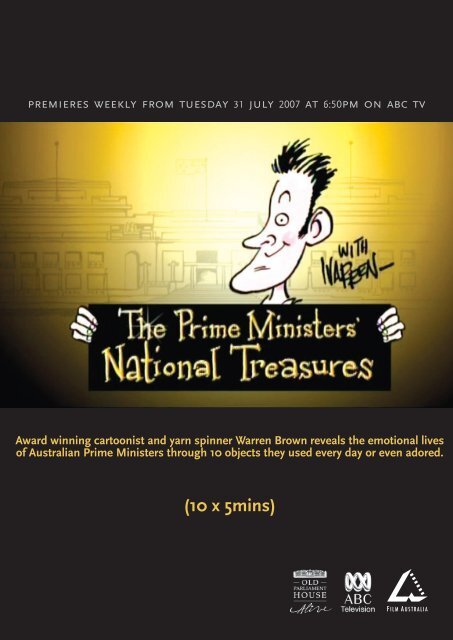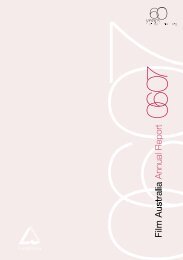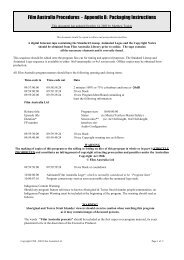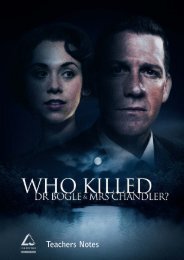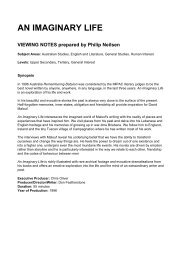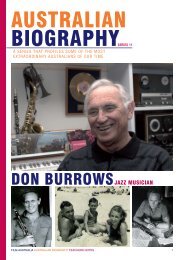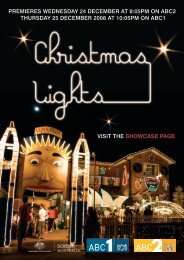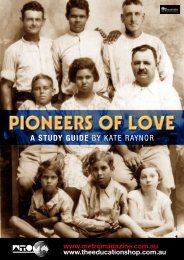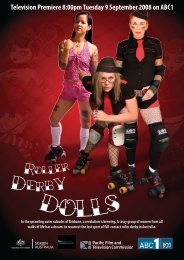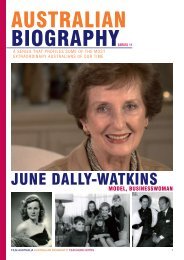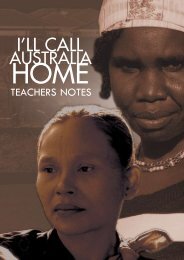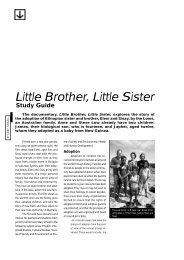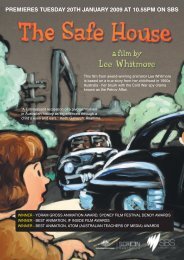The Prime Ministers' National Treasures Press Kit
The Prime Ministers' National Treasures Press Kit
The Prime Ministers' National Treasures Press Kit
You also want an ePaper? Increase the reach of your titles
YUMPU automatically turns print PDFs into web optimized ePapers that Google loves.
premieres weekly from tuesday 31 july 2007 at 6:50pm on abc tv<br />
Award winning cartoonist and yarn spinner Warren Brown reveals the emotional lives<br />
of Australian <strong>Prime</strong> Ministers through 10 objects they used every day or even adored.<br />
(10 x 5mins)<br />
For further information and interviews:<br />
Andy Brown Avisso PR for Film Australia 02 8356 9711 0434 375 994<br />
andyb@avviso.com.au
premieres weekly from tuesday 31 july 2007 at 6:50pm on abc tv<br />
Series synopses<br />
One page<br />
Award winning cartoonist and yarn spinner Warren Brown<br />
takes us on a surprising journey into the hearts and minds<br />
of Australia’s <strong>Prime</strong> Ministers. After months spent foraging<br />
through the nation’s archives, Brown unearths an array of 10<br />
extraordinary objects with countless secrets to tell - Harold<br />
Holt’s last days as revealed in the items he kept in his<br />
briefcase; hundreds of passionate love letters Joseph Lyons<br />
wrote to his wife; John Curtin’s AJA badge, worn every day<br />
whilst he was in offi ce; Andrew Fisher’s tin lunchbox which he<br />
Presenter Warren Brown with his cartoon caricatures of <strong>Prime</strong> Minister James<br />
used when he was just a poor gold miner in Gympie; William Scullin (left), Sir Isaac Isaacs (centre) and King George the Fifth (right).<br />
PHOTOGRAPH BY MARCUS FILINGER. © FILM AUSTRALIA.<br />
Hughes and the vote “yes” for conscription badge; the gold<br />
cigarette case Stanley Melbourne Bruce treasured till the day he died; the wind-up camera Robert Menzies<br />
used to make home movies during the London blitz and many more. <strong>The</strong>se reveal the nation’s leaders as<br />
you have never seen them before.<br />
Versions of the series, specifi cally designed for public exhibition, are showing at <strong>The</strong> Australian <strong>Prime</strong> Ministers<br />
Centre at Old Parliament House in Canberra.<br />
Series Key Credits<br />
<strong>The</strong> <strong>Prime</strong> Ministers’ <strong>National</strong> <strong>Treasures</strong> is a Film Australia <strong>National</strong> Interest Program. Produced in association<br />
with Old Parliament House and the Australian Broadcasting Corporation. © 2007 Film Australia.<br />
www.filmaust.com.au<br />
Series Producer - Paul Rudd<br />
Producer – Perry Stapleton<br />
Director - Matthew Thomason<br />
Writers - Paul Rudd, Matthew Thomason<br />
Presenter - Warren Brown<br />
Film Australia Executive Producer - Penny Robins<br />
ABC Commissioning Editor – Stuart Menzies<br />
Duration – 10 x 5 minutes<br />
For further information and interviews:<br />
Andy Brown Avisso PR for Film Australia 02 8356 9711 0434 375 994<br />
andyb@avviso.com.au
EPISODE 1 – EDMUND BARTON AND THE VELVET SOAP AD<br />
Tuesday 31 July at 6:50pm<br />
<strong>The</strong> Velvet Soap advertising campaign is a tongue-in-cheek reminder of<br />
Edmund Barton’s hand in formulating the White Australia policy. Barton<br />
also helped draft the Federal Constitution, created the High Court, and<br />
presided over the formulation of federal industrial relations and the legal<br />
system. Without him the wayward states may never have federated.<br />
Edmund Barton was <strong>Prime</strong> Minister of Australia from January 1901 to September<br />
1903. <strong>The</strong> Velvet Soap ad is held at Old Parliament House in Canberra.<br />
EPISODE 2 – ANDREW FISHER’S LUNCHBOX<br />
Tuesday 7 August at 6:50pm<br />
Billboard poster, designed by Charles Nuttall,<br />
advertising Velvet soap, featuring the fi rst three Justices<br />
of Australia’s High Court; Sir Edmund Barton, Sir<br />
Samuel Griffi th and Richard O’Connor, 1903-5.<br />
PHOTO COURTESY OF THE OLD PARLIAMENT<br />
HOUSE COLLECTION.<br />
Andrew Fisher’s tin lunchbox reminds us that humble beginnings informed his formidable political career:<br />
leaving school at 10, he was a coalminer throughout his teens, and migrated to Australia at 23. He rose<br />
quickly from union organiser to three-time <strong>Prime</strong> Minister, inventing the Australian ideal of “a fair go” along<br />
the way. Among a host of policies designed for the common good, he advocated maternity allowances and<br />
greater political equality for women.<br />
Andrew Fisher was <strong>Prime</strong> Minister of Australia three times; from November 1908 to June 1909, April 1910 to June 1913,<br />
September 1914 to October 1915. Andrew Fisher’s lunchbox is held at the Gympie Gold Mining Museum in Queensland.<br />
EPISODE 3 – WILLIAM HUGHES AND THE 1916 CONSCRIPTION BADGE<br />
Tuesday 14 August at 6:50pm<br />
<strong>The</strong> irascible William Hughes was a popular and dynamic politician despite a tendency to feud. He burned<br />
through 100 secretaries during his term in offi ce, helped found the Labor party, the <strong>National</strong>ist Party,<br />
and the United Australia Party and was ousted from all three. “<strong>The</strong> Little Digger” as he became known,<br />
campaigned twice for the deeply unpopular concept of national conscription in order to boost an Australian<br />
army decimated by some of the bloodiest offensives of World War One. He formed the Commonwealth<br />
Police Force after a dissenter socked him with an egg and the state police force did nothing.<br />
William Hughes was <strong>Prime</strong> Minister of Australia from October 1915 to February 1923. <strong>The</strong> 1916 Conscription<br />
Badge is held at the Powerhouse Museum in Sydney.<br />
EPISODE 4 – STANLEY MELBOURNE BRUCE’S CIGARETTE CASE Tuesday 21 August at 6:50pm<br />
Until the day he died, Stanley Melbourne Bruce kept two photographs on his desk – one of his wife and one<br />
of Turkish President Mustafa Kemal Atatürk, the founder of the modern Turkish state. As young men they<br />
were enemies at Gallipoli, but during the post-war years of international reconstruction, they forged a mutual<br />
admiration as passionate advocates of secular democracy. After the League of Nations Montreux conference<br />
in 1936, Atatürk presented Bruce with a gold cigarette case, which he treasured for the rest of his life.<br />
Stanley Melbourne Bruce was <strong>Prime</strong> Minister of Australia from February 1923 to October 1929. Stanley Melbourne<br />
Bruce’s Cigarette Case is held at the <strong>National</strong> Archives of Australia in Canberra.<br />
For further information and interviews:<br />
Andy Brown Avisso PR for Film Australia 02 8356 9711 0434 375 994<br />
andyb@avviso.com.au
EPISODE 5 – JAMES SCULLIN AND THE GCMG Tuesday 28 August at 6:50pm<br />
When Labor won the 1929 election, at the height of the Depression, the new <strong>Prime</strong> Minister, James Scullin,<br />
refused to take up residence in <strong>The</strong> Lodge. Instead, he offered to rent it out to defray the costs of the <strong>Prime</strong><br />
Ministership – an act which would be unthinkable today. Scullin was determined, and even when his mission<br />
to appoint an Australian-born Governor General met with furious opposition and public disapproval, he<br />
insisted on appointing one - Sir Isaac Isaacs. King George V was not amused, but the precedent had been<br />
set and Isaacs was anointed to the Order of St Michael and St George as Knight Grand Cross (GCMG) and<br />
presented the insignia chain.<br />
James Scullin was <strong>Prime</strong> Minister of Australia from October 1929 to January 1932. <strong>The</strong> GCMG is held at the<br />
<strong>National</strong> Library of Australia in Canberra.<br />
EPISODE 6 – JOSEPH LYONS’ LOVE LETTERS<br />
Tuesday 4 September at 6:50pm<br />
<strong>The</strong> Depression had fi nally ended when Joseph Lyons came to<br />
power. Lyons and his adored wife and confi dante, Enid, presented<br />
a genuine picture of domestic harmony and security to the<br />
Australian public despite the many separations they endured as<br />
he commuted from the family home in Tasmania to the Australian<br />
capital. Politics rarely produces impassioned romantics, which is<br />
just what makes the hundreds of letters Joseph Lyons wrote to<br />
Enid as fascinating as they are unexpected. He died in offi ce and<br />
Enid went on to become the fi rst female member of the Federal<br />
House of Representatives.<br />
Presenter Warren Brown’s watercolour caricature of <strong>Prime</strong> Minister Joseph Lyons.<br />
Joseph Lyons was <strong>Prime</strong> Minister of Australia from January 1932 to<br />
April 1939. Joseph Lyons’ Love Letters are held at the <strong>National</strong> Library<br />
of Australia in Canberra.<br />
Presenter Warren Brown’s watercolour caricature of <strong>Prime</strong> Minister Robert Menzies.<br />
<strong>Prime</strong> Minister Joseph Lyons’ love letters to his wife Enid.<br />
PHOTOGRAPH BY MARCUS FILINGER. © FILM AUSTRALIA<br />
EPISODE 7 – ROBERT MENZIES’ CAMERA<br />
Tuesday 11 September at 6:50pm<br />
Robert Menzies served his first term as <strong>Prime</strong> Minister<br />
during World War Two. In 1941 he travelled to England to see<br />
the bombing of London first hand. He was shocked. He also<br />
believed Singapore would fall if the Japanese entered the war,<br />
which strained his relationship with Churchill. Menzies took<br />
his wind-up camera everywhere he went, and his very personal<br />
record of the visit includes strikingly informal footage of a young<br />
Princess Elizabeth.<br />
Robert Menzies was <strong>Prime</strong> Minister of Australia twice; from April 1939 to August 1941 and December 1949 to<br />
January 1966. Robert Menzies’ Camera is held at the <strong>National</strong> Museum of Australia in Canberra.<br />
For further information and interviews:<br />
Andy Brown Avisso PR for Film Australia 02 8356 9711 0434 375 994<br />
andyb@avviso.com.au
EPISODE 8 – JOHN CURTIN’S AUSTRALIAN JOURNALISTS’ ASSOCIATION BADGE<br />
Tuesday 18 September at 6:50pm<br />
John Curtin started out as a copy-boy on <strong>The</strong> Age, working his way up the ladder via the union movement.<br />
He joined the Australian Journalists’ Association (AJA) in 1917 and was elected State President in 1920,<br />
before moving into politics. Twenty years later he reached the top, becoming Australia’s fourteenth <strong>Prime</strong><br />
Minister. His affi nity with the press served him well during the arduous years of World War Two, when he<br />
kept newspaper editors onside with regular press briefi ngs, even revealing dispatches from Churchill. He<br />
wore his AJA badge every day he was in offi ce.<br />
John Curtin was <strong>Prime</strong> Minister of Australia from October 1941 to July 1945. John Curtin’s Australian Journalists’<br />
Association Badge is held at the John Curtin <strong>Prime</strong> Ministerial Library in Perth.<br />
EPISODE 9 – BEN CHIFLEY’S PIPE<br />
Tuesday 25 September at 6:50pm<br />
Possibly our best loved <strong>Prime</strong> Minister, Ben Chifley<br />
was a former train driver with a voice like worn out<br />
boot leather. He was well aware that his image as the<br />
typical bloke next door – he was rarely seen without his<br />
tobacco pipe - helped to sell an ambitious raft of post<br />
war reconstruction projects to the Australian public.<br />
He was also a gifted treasurer, prone to personal and<br />
professional thrift, which allowed him to set the stage<br />
for Australia’s economic boom in the 1950s.<br />
Ben Chifley was <strong>Prime</strong> Minister of Australia from July 1945 to<br />
December 1949. Ben Chifley’s Pipe is held at the Ben Chifley<br />
Home in Bathurst NSW.<br />
Photograph of <strong>Prime</strong> Minister, Ben Chifl ey and young boy with pipes in mouths.<br />
PHOTO COURTESY OF THE LITHGOW MERCURY.<br />
EPISODE 10 – HAROLD HOLT’S BRIEFCASE<br />
Tuesday 2 October at 6:50pm<br />
Presenter Warren Brown (left) with Holt expert Tom Frame in front of Harold<br />
Holt’s briefcase on location at the <strong>National</strong> Archives of Australia in Canberra.<br />
PHOTOGRAPH BY SAM COOPER, NATIONAL ARCHIVES OF AUSTRALIA.<br />
© NATIONAL ARCHIVES OF AUSTRALIA.<br />
<strong>The</strong> disappearance of our seventeenth <strong>Prime</strong> Minister,<br />
Harold Holt, during a beach holiday sparked countless<br />
conspiracy theories and ultimately overshadowed his political<br />
accomplishments. At the height of the cold war, with the<br />
Vietnam War escalating, he had already started to dismantle<br />
the White Australia policy. <strong>The</strong> items left in Holt’s briefcase<br />
are a signifi cant time capsule of his last days as <strong>Prime</strong><br />
Minister: a pair of socks, theatre tickets, his tax returns and<br />
a couple of combs. He is remembered today by <strong>The</strong> Harold<br />
Holt Memorial Baths in Melbourne and a plaque at Cheviot<br />
Beach where he took his last swim.<br />
For further information and interviews:<br />
Andy Brown Avisso PR for Film Australia 02 8356 9711 0434 375 994<br />
andyb@avviso.com.au
About the making of the series<br />
<strong>The</strong> team behind the second series of <strong>National</strong> <strong>Treasures</strong><br />
has had plenty of practice taking unwieldy wedges of<br />
history and fashioning them into palatable spoonfuls of<br />
snappy television. <strong>The</strong> fi rst series included everything<br />
from Bradman’s Bat to Phar Lap’s hide, and even a 160-<br />
year-old convict shirt. Three years later the series is still<br />
running on the ABC.<br />
With the second series, the stakes are higher, and<br />
the terrain a little more challenging. After all, how do<br />
<strong>Treasures</strong> presenter Warren Brown, DOP Paul Gordon and Director Matthew Thomason (left)<br />
filming a scene on location at the <strong>National</strong> Archives of Australia in Canberra.<br />
you create irresistible mini-documentaries out of the PHOTOGRAPH BY SAM COOPER © NATIONAL ARCHIVES OF AUSTRALIA.<br />
personal treasures of ten Australian <strong>Prime</strong> Ministers?<br />
How many people in the twentieth century can relate to these rather severe historical entities, with their<br />
stiff faces and improbable facial hair? As for their achievements – just hearing the word “Federation” has<br />
induced stomach cramps and myopia in generations of Australian school children.<br />
All this is about to change. <strong>The</strong>se founding father’s have been exhumed, brushed down, and lit up like heroes,<br />
for the latest collection of <strong>National</strong> <strong>Treasures</strong>. <strong>The</strong> series producer Paul Rudd, says viewers will be impressed by<br />
the new series, whether they love history or not. This is definitely not sepia television for the over-the-hill set.<br />
Each five minute grab has been “honed until it’s flab free and crystal clear,” says Rudd. “And the truth is, these<br />
men created the Australia we know today. <strong>The</strong>y were remarkably clever, intriguing, people.”<br />
“It’s certainly not academic history,” agrees Matthew Thomason, the series writer/director. “It’s personal.<br />
It goes straight to the heart. It’s about love letters, and home movies, and a gold cigarette case. And each<br />
object tells a bloody good story. <strong>The</strong>re is something irresistible about all of them.”<br />
Every treasure trove needs its sleuth, and Warren Brown, well-known cartoonist, and author, returns as an<br />
enthusiastic presenter with a knack for pumping adrenalin into Australian history.<br />
“Following the trail of our illustrious leaders has made me see what a great country Australia really is!” he says.<br />
“That you could have these homespun characters become <strong>Prime</strong> Ministers says it all. Chifley was a train<br />
driver. Curtin was a copy boy. Fisher left school at ten to work the mines. Australia was like a science lab<br />
of political experiments and these guys came in at ground zero. <strong>The</strong>y started from scratch. I’m amazed by<br />
how progressive they were!”<br />
As for the objects themselves, some are very personal items, says Brown, and others are totally surprising.<br />
“When I started to read Joseph Lyons’ love letters to his wife, I found them very moving. But my favourite<br />
is the gold cigarette case. It symbolizes such an unexpected friendship. This series has totally changed the<br />
way I think about Australia’s <strong>Prime</strong> Ministers.”<br />
For further information and interviews:<br />
Andy Brown Avisso PR for Film Australia 02 8356 9711 0434 375 994<br />
andyb@avviso.com.au
About the presenter – Warren Brown<br />
As a fulltime cartoonist for the Sydney Daily Telegraph, Warren Brown<br />
spends most of his time immersed in the argy-bargy of the metropolitan<br />
newspaper world. To escape he plays the banjo, tinkers with his vintage<br />
fi re engine and armoured car and writes the odd book. Consequently<br />
Warren is a regular on various television current affairs programs –<br />
most recently as the cartoonist on Difference of Opinion (ABC TV). In<br />
2003 he was one of the subjects of Hired Assassins – Political Cartooning<br />
in Australia, a searing documentary about Australian cartoonists<br />
(distributed by Film Australia). In 2006 Brown conceived and narrated<br />
the Logie nominated ABC TV series Peking to Paris – a 16,000km drive<br />
across China, Mongolia and Russia in fi ve 100 year-old cars identical<br />
to the originals in the race of 1907. Brown also co-authored the bestselling<br />
coffee table book Peking to Paris (based on the television series<br />
and published by Harper Collins). A keen history buff, Warren was the<br />
offi cial overnight MC at Anzac Cove and Lone Pine War cemeteries at<br />
Gallipoli on Anzac Day (2006, 2007, 2008). In 2007 he was nominated<br />
for a Best New Talent Award for his ABC radio program Weekender. In<br />
response to overwhelming popular demand, he has returned for the<br />
second series of <strong>National</strong> <strong>Treasures</strong>.<br />
Presenter Warren Brown.<br />
PHOTOGRAPH BY BRAD RIMMER. © FILM AUSTRALIA.<br />
About the writer/director – Matthew Thomason<br />
Matthew Thomason has a BA majoring in <strong>The</strong>atre and Media, and has worked in television as a segment<br />
producer, writer/director and series producer since 1985. He started in television as a copywriter at Capital<br />
Seven, Canberra. From 1988 to 1990, he worked for Beyond Productions. From 1991 to 1995, he was a<br />
segment producer for the Nine Network on 35 Years of Television and Getaway. He was writer/director on<br />
the nature documentary series Deadly Australians and Salute – Australians at War. He spent the next three<br />
years writing and producing science shows and sporting programs before returning to Getaway as series<br />
producer in 1998-99. In 2000, he began working at Grundy Television, writing, producing and directing<br />
entertainment pilots and entertainment retrospectives. In 2003 he was Senior Producer on Network Ten’s<br />
Australian Idol, the highest rating show in the network’s history.<br />
About the series producer/writer – Paul Rudd<br />
Paul Rudd cut his teeth as an editor in regional television before joining the Nine Network in 1988 as<br />
Features Editor on top shows including Live at Five, A Current Affair, Today, Eye on Australia and Burke’s<br />
Backyard. In 1992 he worked as Series Director/Producer on Getaway, Sex and Deadly Australians. In 1994<br />
he was Executive Producer of 50 Fantastic Years and Salute–Australians at War. Over the next six years Paul<br />
executive produced reality TV, entertainment specials and Nine’s 30-hour Millennium Live coverage. Paul<br />
left the Nine Network in September 1999 and has since produced Andrew Denton’s Olympics Exposed<br />
for Channel 4 in the UK and Nature’s Born Killers, a documentary series with Michael Willesee, as well as<br />
series producing and writer/directing the landmark three-hour series Colour of War–<strong>The</strong> Anzacs for Film<br />
Australia’s <strong>National</strong> Interest Program.<br />
For further information and interviews:<br />
Andy Brown Avisso PR for Film Australia 02 8356 9711 0434 375 994<br />
andyb@avviso.com.au
Links<br />
Film Australia<br />
www.fi lmaust.com.au<br />
Investigating <strong>National</strong> <strong>Treasures</strong><br />
http://www.nationaltreasures.com.au/<br />
<strong>The</strong> Australian <strong>Prime</strong> Ministers Centre<br />
http://www.apmc.oph.gov.au/<br />
Australia’s <strong>Prime</strong> Ministers<br />
http://primeministers.naa.gov.au/<br />
<strong>Prime</strong> Ministers of Australia<br />
http://www.nma.gov.au/<br />
Past <strong>Prime</strong> Ministers<br />
http://www.pm.gov.au/past_pm/index.cfm<br />
<strong>National</strong> Library of Australia<br />
http://www.nla.gov.au/<br />
<strong>National</strong> Archives of Australia<br />
http://www.naa.gov.au/<br />
John Curtin <strong>Prime</strong> Ministerial Library<br />
http://john.curtin.edu.au/<br />
Powerhouse Museum, Sydney<br />
http://www.powerhousemuseum.com/<br />
Gympie Gold Mining & Historical Museum<br />
http://www.gympiemuseum.com/<br />
<strong>National</strong> Museum of Australia<br />
http://www.nma.gov.au<br />
For further information and interviews:<br />
Andy Brown Avisso PR for Film Australia 02 8356 9711 0434 375 994<br />
andyb@avviso.com.au


